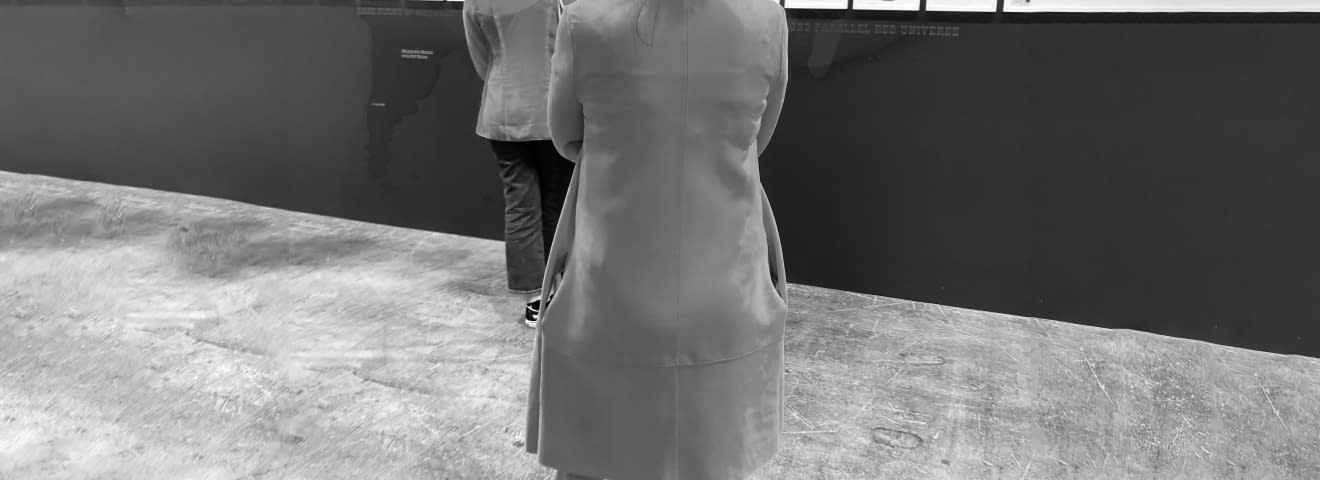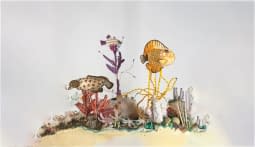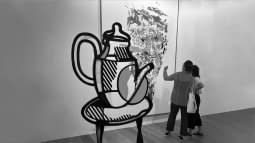art24 vs. Art Basel
Once a year, the world's most renowned galleries and selected works of art by the artists who are represented at these galleries are exhibited at Art Basel. The 54-year-old Art Basel gained a high profile for the international professional audience early on, as it was founded by renowned gallery owners and art lovers and has since had a formative influence on the art market and trade. During the Art Basel visit of the art team of art24 on 17 June 22 (the impressions of which can be read in the blog «art24 goes Art Basel»), questions arose as to how art24 differs from the world-renowned art fair and where they are perhaps similar. What are the advantages and disadvantages of the respective platforms? Is there a competitive relationship? Do they harmonise in their existence side by side and could they even complement each other? To what extent can online platforms like art24 influence the art market in the future or even change and determine its direction?
The comparison of the two platforms will be discussed in more detail below.
In advance, we would like to emphasise that this is not an exercise in criticism of the Art Basel fair. The internationally renowned art fair is rightly so successful because it exhibits significant art from Classical Modernism to the present from the world's most renowned galleries in one spot every year. It must therefore be noted that the art24 art team is a big fan of Art Basel too!
History and visions of both platforms
Art Basel was founded in 1968 by Trudl Bruckner, Balz Hilt and Ernst Beyeler. Since then, the art fair has provided an annual platform for up to 300 international exhibitors and attracts tens of thousands of visitors on four exhibition days a year. Since 2022, the fair has been held not only in Basel, its founding city, but also in Miami Beach (USA), in Hong Kong since 2013 and, since 2022, in Paris.
The idea for art24, an online art/artist platform, was born in 2015. art24 only went live at the beginning of the year 2022, on 22 February 2022. Since then, it has over 800 international artists, both living and deceased, and over 2,500 works of art for sale. While the platform is currently mainly focused on the German-speaking world, art24 is aiming for future expansion to England, France, the USA, China, etc.
A further goal of art24 is the presentation of galleries, museums and fairs as well as the possibility for private sellers, art collectors, institutions, foundations and estates to sell their works on the website. The main objective of art24 is to provide a platform for all artists, regardless of their level of recognition, professional experience, age, social/financial status, and to enable them to sell art fairly by considering them as independent artists in their own right.
Form of presentation: art fair versus the digital art experience
A pretty obvious difference is the form of presentation of both platforms. Unlike Art Basel, which is to be understood as an art fair to be visited physically, art24 exists digitally. This has some advantages for art24. As an international online platform, it offers (digital) borderless, all-year-round, 24-hour access to artworks from all over the world from anywhere for anyone, provided they have Internet/WLAN access. The website is available to a broad customer base of private buyers (who may be approaching art for the first time without fear of approaching a certain market), collectors, professionals, investors, etc. and can be visited free of charge. It offers art for EVERYONE - in the two- to seven-figure price segment.
In this respect, the Art Basel art fair appeals more to the specialist public and, as a platform for galleries, to the wealthy, elite, art-affine clientele, who are even classified again: the first Art Basel day is reserved for selected VIPs. Accordingly, a visit to the international art fair has its financial price for every visitor, including entrance tickets and possible travel and accommodation costs.
With art24, the artist profiles and the artworks for sale can be viewed without registration. However, registration is necessary if the customer is interested in buying. This enables the customer to contact the seller of the work directly and to negotiate the sale. This becomes immediately personal and opens a dialogue between the buyer and the artist/seller. Although the work of art can only be viewed on the website, each artist is free to offer a physical viewing of the work for the interested buyer. In this sense, art24 does not see itself as an online gallery with an era-, country- or genre-specific art selection or programme that is presented in exhibition spaces à la Art Basel, but rather offers art-related networking opportunities.
For a specific period of four days, Art Basel guarantees a visit to the showrooms of renowned galleries and their artists. Those interested are forced to travel to the venue. The «Art Basel Live» function has existed for two years. «Live» is switched on via Instagram and «WeChat» in situ from the art fair and makes it possible for visitors who are not able to be there to experience the fair at least digitally and in real time. In so-called «Online Viewing Rooms», the galleries can present their exhibited artworks online and provide insights behind the scenes. Furthermore, conversations with people from the art world, from artists and collectors to curators and art critics, take place in podcasts or the «Conversation» segment. These dialogues are accessible to the public and online. While «Art Basel Live» allows for a free visit to the fair, like the actual exhibition space in Basel, it only exists for the specific time period. Likewise, due to the mass, it is not possible to go into each individual exhibition work. The gallery artworks and those in the Unlimited Showrooms will also not be posted individually on the Art Basel website. So anyone who is actually interested in buying works will have to see for themselves on site. This would be recommended anyway, as the galleries' showrooms often do not have prices or even information about the works or, in some cases, the artists. Here, direct contact with the gallery owners is necessary, even if this seems less approachable and personal. In the Unlimited exhibition, too, the artists themselves are not present (as is usually the case in galleries/museums). However, insights into the artworks can be gained by means of so-called «Guided Tours» or «Guards». If you are interested in a digital visit, the names of the exhibiting galleries and artists are listed on the website.
Exhibitors/artists and art for sale
The «Selection Committee» of Art Basel, consisting of international gallery owners, decides on the exhibitors to be presented. The committee selects the participating galleries, which have to apply in advance each year.
An art commission of art24 staff, consisting of art historians, art restorers and Germanists, plays a decisive role in shaping the content of the art24 website. They have access to the artists to be promoted, reserve the right to approve artworks on the platform, manage profiles of partner galleries or can arrange for the deletion of a dubious artist profile in order to ensure the quality of the profiles and the art on the platform.
While at Art Basel selected works by selected artists are typically presented in the participating selected galleries and the Unlimited exhibition, at art24 any artist can register free of charge. There is no pre-selection of registered artists, as art24 is freely available to all. All registered artists are also permitted to create their own artist profile, in which 24 self-described works of art can be uploaded to their own portfolio free of charge. The profile page is visible on the website for every visitor without prior registration.
A subscription is required in order to sell art on the art24 platform. While the participating galleries pay for their space at Art Basel, the artists contribute with a subscription to uploading their works for sale on the international platform. The cost of the subscription depends on the number of works to be sold. Compared to gallery artists, however, they keep the entire sales amount without having to give up commission. In addition to the conditions of sale, they themselves determine the packaging of the work, the transport or collection, etc., through direct contact with the buyer. At Art Basel, on the other hand, the sale of the artwork takes place through the gallery. The negotiated commission of the sold price, which is usually between 30-60%, goes to the gallery. The remaining amount goes to the artist. Since the galleries market the artists, they cannot exert any further influence on the negotiation of the sale and are sometimes even subject to contractual restrictions (e.g., temporal regulation of exhibitions, no further contracts with other galleries, etc.).
A matter close to art24's heart is the promotion of individual, financially-supportable or young emerging artists. By explicitly selecting these artists from the art24 art team or by having them apply for support, it is possible to respond individually to the artist. Previous support options include a reduction or, in special cases, even a release from subscription costs, marketing on social media and mentions in blog posts as well as invitations to special art24 events. Artists with a certain reach on social media, on the other hand, can apply as «promoted artists». Here, too, the same promotional measures apply, but assistance in spreading the name of art24 on social media is a requirement. As art24 is a platform by artists for artists with an experimental character, it wants to let the artists speak as a community, to make them be heard with the platform and to increase their level of awareness. Artists with a subscription will be given the opportunity to present their story and their oeuvre in a blog entry they have created themselves. In addition, they will be able to inform web visitors about current exhibitions, openings, workshops, etc. with the help of an event calendar.
Conclusion: Platforms for the art world
The most obvious difference between art24 and Art Basel is easily found. While the former is an international online art / artist platform, the latter functions as a recognised international art fair that can be physically visited. It is not only the form of presentation of the two platforms that differs, but also their content. Art Basel is a platform of gallery owners for galleries. art24 is a platform of artists for artists. While galleries have to apply to participate at the fair, every artist is welcomed on the online platform, regardless of status, age, gender, recognition or name recognition. The artists of art24 are freer, more independent, they can create their own profiles, manage their own artworks and their sales. Without any obligations to a gallery.
However, both Art Basel and art24 provide a venue for the diverse art world. In both cases, however, an art committee determines the quality of the exhibitors presenting and the artworks presented on the platform. Criminally prosecutable, racist, sexist and/or discriminatory content of any kind has no place on the art24 platform. Thanks to Art Basel's powerful and recognised position in the art world, the annual focus is on historical and contemporary art. Such art fairs are needed to attract an international audience and investors. The fact that, in addition to the expensive presentation of the most influential galleries, there is a need for a fair, suitable, central presentation of artists is made clear by the founding of side fairs such as the Liste or artist platforms such as art24. At the discovery fair «Liste Art Fair Basel», the lesser-known young galleries and their contemporary artists are exhibited. Founded in 1995, the side fair to Art Basel also offers the new formats «Liste Showtime» and «Liste Expedition Online» from 2020 and 2021. As a «digital art fair», Liste Showtime offers an online platform for the international galleries, which can present one of their represented artists on the website and offer the works for sale. However, the digital version of the art fair also only takes place during the specific period of 7 days during which the fair is held in Basel. The second format (List Expedition Online) functions as a non-commercial digital discovery and research forum with a growing index of artists. It contains information on the artists presented at the digital fair Liste Showtime. The platform is available all year round and thus comes somewhat closer to the philosophy of art24. However, both formats of the list again represent a platform for selected galleries and their artists.
While individual artists do not receive the appropriate focus at the art fairs, and likewise only those who are already represented in important galleries, they can build up and individually expand their independence on the online platforms. Whereas fairs prescribe and decide which art is outstanding in order to be presented to an international professional audience and the art elite, potential customers or visitors to the online platform are invited to form their own opinion about the quality of an artwork and decide whether to buy it, freely according to their own taste, with a lot or little previous knowledge and financial means.
We think that Art Basel is not in competition with art24. There is also no need for a division between the two platforms, but rather for a complementary interplay. As described, it is important that art fairs exist. The physical encounter with a work is a different, perhaps more intense experience than via the screen. Meeting investors is also important. This keeps art on the market and provides financial support and funding. But still, fairs are always opinion-forming. A kind of censorship exists that decides what is «good» or «valuable» art. This does not exist on the art24 platform. It offers ALL artists a platform on which they can present themselves as they wish.
Ideally, the art24 platform offers a springboard for artists who may exhibit at Art Basel or at the side fairs in the future. With the online platform, we shed light on those who are promoted by our art team and offer them new opportunities on the art market.
Readers are welcome to take part in the discussion in the comment function of the social media channels and to formulate their own thoughts on the subject. Where does the future lie? In the emerging, digital and new art experience? Or will the concept of (gallery) art fairs (continue to) prove itself? In the future, can online platforms perhaps induce a rethinking of influential and powerful art fairs like Art Basel and, as a faster medium, influence new trends in the art scene in an opinion-forming way? Or will online-offline platforms enrich each other?
Why art24 distances itself from the idea of an institution is discussed in the blog post «A look at institutional critique and why art24 enables more diversity» by Yvonne Roos and is recommended as further reading. Likewise the post «Platform instead of gallery?» by Cécile Fuchs, which explores the question of why an art platform is needed when galleries exist.
In any case, it is important that art and artists continue to be promoted, discussed, shown and enlivened.








